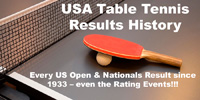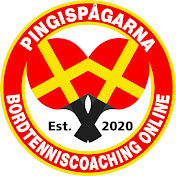September 22 - Power in Table Tennis
Power in Table Tennis
Some players can blast the ball a zillion miles per hour with hyperbolic spin while seemingly barely trying, while others grunt and grimace and can't break a soap bubble. So where does power in table tennis come from? Power comes primarily from eight factors. They are:
- Equipment. Offensive rackets and sponges add to whatever power you put on the ball.
- Strength. It makes a difference, though not as much as some would seem.
- Muscle Elasticity. This is probably more important than sheer strength. It's a primary reason why older players, even if they weight train, lose power as their muscles lose their elasticity. Elastic muscles are like slingshots.
- Body Mass and Type. If you rotate your body into the shot, you put your mass into the shot, and more mass means more power. You also might get more power potential from longer arms, the type of muscle (fast-twitch vs. slow-twitch), and even the way the muscles are connected.
- Type of Contact. If you graze the ball too finely you lose the power potential from the sponge as well as speed. If you sink it directly into the sponge you gain speed from hitting directly into the wood, but lose power that might be generated by the sponge if you contact at more of an angle.
- Proper Technique. This maximizes power generation as well as your ability to control it.
- Timing of Muscle Contractions. Each muscle gets the next one started, and if it's not timed properly, you lose power.
- Timing of Contact. If contact is not done at the point of maximum power, you lose power.
Let's elaborate on the last two - the timing issues. There are two types of timing when stroking the ball, and both lead to power. (Proper technique technically would include the two timing issues below, but I'm separating them here - but without good technique your power potential is severely limited.)
Timing of Muscle Contractions. Each muscle gets the next one started. The proper order for a forehand stroke is legs, hips, waist, shoulder rotation, shoulder, elbow, and wrist. (Wrist is optional on some shots.) If one contracts a muscle too soon or too late you lose power. If you contract any muscle too hard it becomes nearly impossible to control or to time them all together, so you only contract at whatever percent you can consistently and smoothly control - perhaps 70%, perhaps more on easy high balls.
Timing of Contact. Contact should take place when the racket approaches maximum speed. Technically, you shouldn't contact the ball when the racket is at maximum speed; you want to accelerate through contact, meaning the racket actually speeds up as you contact the ball, and so is slightly faster the split second after contact. (This might be where physicists can chime in, but from a coaching point of view, this is a key issue - far too many players lose power because they stop accelerating before contact, thereby dissipating some of their power. Or is this an illusion, and you get maximum power by reaching maximum velocity right at contact, meaning zero acceleration at that point?)
So how can you increase your power? All of the items above are factors, though I don't recommend gaining weight (other than muscle mass) to increase power. (I'm not sure how much of a factor that really is, but it's greatly offset by the loss of mobility.) Physical training can help with strength and muscle elasticity. But most of power potential comes from items 5-8 above. A coach can greatly help you with these. When I watch players who have trouble generating power - which is most players - I find that the the most common problems are those that a coach can solve - the technique and timing issues. Grunting and grimacing are just indications that the player is having technique and timing problems that keep him from getting that easy power that comes so easily to some players. (See my related Tip on this, Easy Power.)





